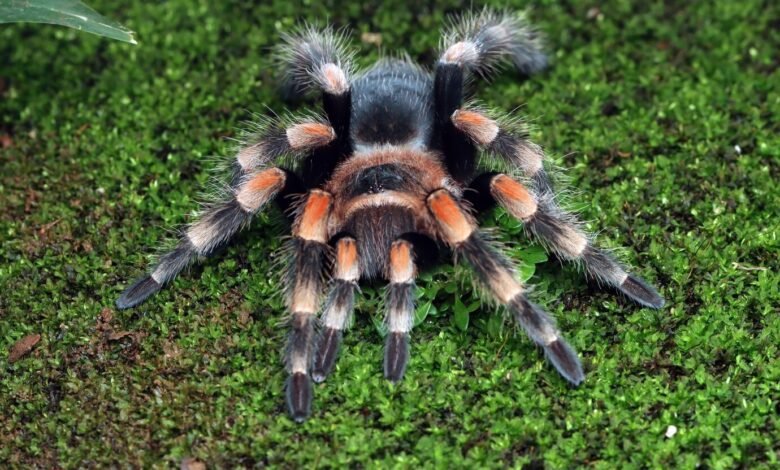Cobalt Blue Tarantula: A Stunning Jewel of the Spider World

The cobalt blue tarantula (Haplopelma lividum) is one of the most mesmerizing and sought-after spiders in the arachnid hobby. Known for its striking iridescent blue legs and deep velvety black body, this tarantula captivates enthusiasts and researchers alike. Native to the tropical forests of Myanmar and Thailand, this species is as elusive as it is beautiful, often spending most of its time in underground burrows. Despite its stunning appearance, the cobalt blue tarantula is known for its defensive nature, making it a species recommended for experienced keepers rather than beginners. In this article, we will explore its habitat, behavior, care requirements, and conservation status, providing a comprehensive guide for anyone fascinated by this extraordinary spider.
1. Appearance: A Dazzling Display of Blue
The cobalt blue tarantula is renowned for its vibrant blue coloration, which is most intense on its legs and carapace. Unlike many tarantulas that rely on muted browns and blacks for camouflage, this species stands out with its metallic blue sheen, especially under direct light. The abdomen is typically a deep black or dark blue, creating a stunning contrast. Females tend to exhibit more vivid colors than males, which often appear duller as they mature. This striking appearance has made the cobalt blue tarantula one of the most photographed and desired species in the pet trade.
2. Natural Habitat: The Secretive Burrower
In the wild, the cobalt blue tarantula inhabits the tropical rainforests and moist regions of Myanmar, Thailand, and parts of Southeast Asia. Unlike arboreal tarantulas, this species is obligate fossorial, meaning it spends nearly its entire life underground in deep, self-dug burrows. These burrows help maintain high humidity levels, which are crucial for the spider’s survival. The tarantula rarely ventures out except to hunt or during mating season, making sightings in the wild exceptionally rare. Deforestation and habitat destruction pose significant threats to its natural environment, contributing to its declining wild populations.
3. Behavior: Defensive and Fast-Moving
While the cobalt blue tarantula is a visual marvel, it is not a species known for its docility. It is highly defensive and skittish, often resorting to threat postures, flicking urticating hairs, or delivering a painful bite if provoked. Unlike some New World tarantulas that may tolerate handling, this Old World species is not recommended for beginners due to its aggressive temperament and potent venom. Additionally, it is an extremely fast-moving spider, capable of darting away in the blink of an eye, making escape a real risk during enclosure maintenance.
4. Care in Captivity: A Challenge for Experienced Keepers
Keeping a cobalt blue tarantula requires specific conditions to mimic its natural habitat. A deep substrate (at least 6-8 inches) of moist coconut fiber or peat moss is essential to allow for burrowing. The enclosure should maintain high humidity (70-80%) and a temperature range of 75-85°F (24-29°C). Unlike other tarantulas, this species prefers minimal disturbance, so frequent handling should be avoided. Feeding consists of live insects such as crickets, roaches, and mealworms, provided once or twice a week. Due to its reclusive nature, keepers may rarely see their tarantula outside of its burrow, making it a pet more for observation than interaction.
5. Conservation Status: Threats and Protection Efforts
The cobalt blue tarantula faces growing threats from habitat destruction, illegal pet trade, and climate change. While not currently listed as endangered, its limited natural range and slow reproductive rate make it vulnerable. Conservation efforts focus on protecting its native forests and regulating the exotic pet trade to prevent overharvesting. Responsible breeders in captivity help reduce the demand for wild-caught specimens, ensuring that future generations can continue to admire this magnificent arachnid.
Conclusion: A Beautiful but Demanding Species
The cobalt blue tarantula is undoubtedly one of the most awe-inspiring tarantulas in the world, captivating keepers with its vibrant colors and elusive nature. However, its aggressive temperament and specialized care needs make it suitable only for experienced arachnid enthusiasts. By understanding its natural behaviors, habitat requirements, and conservation challenges, we can better appreciate and protect this jewel of the spider kingdom. Whether admired in the wild or kept in captivity, the cobalt blue tarantula remains a testament to nature’s breathtaking beauty.
